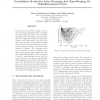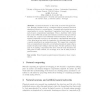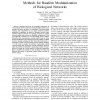1077 search results - page 132 / 216 » Learning network structure from passive measurements |
UAI
2003
13 years 9 months ago
2003
In this paper we present a family of models and learning algorithms that can simultaneously align and cluster sets of multidimensional curves measured on a discrete time grid. Our...
KDD
2003
ACM
14 years 8 months ago
2003
ACM
Data Mining with Bayesian Network learning has two important characteristics: under broad conditions learned edges between variables correspond to causal influences, and second, f...
UC
2009
Springer
14 years 2 months ago
2009
Springer
Abstract. Dynamical structure in the brain promotes biological function. Natural scientists look for correlations between measured electrical signals and behavior or mental states....
ENGL
2007
13 years 7 months ago
2007
—“A General Reflex Fuzzy Min-Max Neural Network” (GRFMN) is presented. GRFMN is capable to extract the underlying structure of the data by means of supervised, unsupervised a...
BIBE
2006
IEEE
14 years 1 months ago
2006
IEEE
— Biological networks are formalized summaries of our knowledge about interactions among biological system components, like genes, proteins, or metabolites. From their global top...



